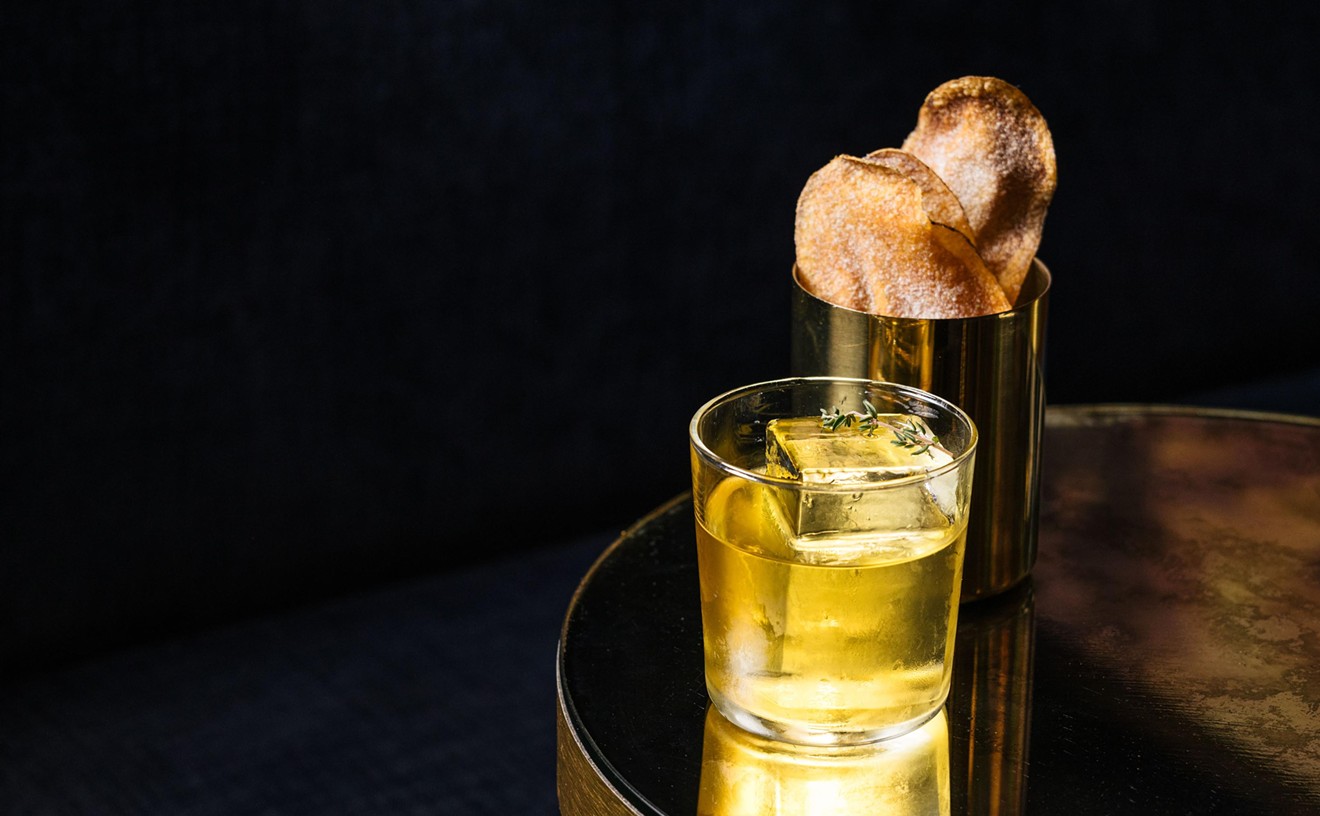Once upon a time, in a very rich country, the people elected a president who helped them become even richer. Soon, there was so much money to spend, the people didn't know what to do with it all. They bought big boats and big TVs and fancy watches and called them "toys." They gave their money to drug dealers, imported car dealers and wheeler-dealers. They ate lobster and steak and duck every night until a funny thing happened. The people grew bored.
Fortunately, a clever chef in a city near the ocean had an idea. "I know," he announced. "I will invent a new cuisine for these rich, bored people who have too much money to spend. I will use the silliest and rarest of ingredients: oils extracted from seed pits, exotic mushrooms harvested at midnight, cheese made from the milk of goats found only on remote European mountaintops."
As the chef visualized the money to be made, he rubbed his hands together. "Portions will be small," he said. "But desserts will be gigantic. And no one will dare question anything, because no one will wish to look that stupid, that foolish, that declasse.
"And then," he said. "I will be rich, too."
And it came to pass that everything the chef said came true. People flocked to his restaurant, sometimes fighting each other for tables. Other chefs saw this and were impressed. The new cuisine spread like wildfire across the land. Price was no object, and in this manner, much income was redistributed.
Thousands of heads of radicchio later, what I like to call "fou fou" cuisine lives on. Barrels of balsamic vinegar, seasons of sun-dried tomatoes, acres of arugula have been sacrificed in its name. And now, like the child who spots the emperor wearing only his underwear, I am willing to say "Enough is enough."
I'm through with "fou fou."
You can thank the Orangerie at the Arizona Biltmore for this epiphany.
Executive chef Peter Hoefler's new spring menu is pretentious and ridiculous. Every noun is preceded by exotic modifiers: "Kuari smoked pineapple," "Malibu greens," "Bliss potato." Ingredients you'll never taste or see are enumerated. "Glazed root vegetables" pose for turnips. If you go, be sure to study your LaRousse Gastronomique beforehand or bring someone well-versed in "fou fou."
Naturally, such verbosity doesn't come cheap. I've calculated the word-to-cost ratio. Appetizers go for anywhere from 60 cents to a dollar a word, entrees $1.50 to $2.70 a word. Many of the descriptions are only slightly smaller than the actual dish.
For instance, the nine-word "grilled chirashi sashimi, marinated asparagus tip, grapefruit mustard sauce" menu item yields a twelve-piece appetizer. My faithful dining accomplice Goat and I receive exactly four tiny strips of slightly grilled tuna, four asparagus tips and four sections of grapefruit. Hmmm, I thought it said "grapefruit mustard sauce." Silly me, for being so literal.
After we've consumed the meager contents of the ten-dollar sashimi plate, Goat asks me how much I think it is really worth. "Six-fifty?" I suggest. "No way," he chastises. "A dollar-fifty, tops."
And so it goes.
Another example of description-reality dissonance is the "crispy Appalachi Kola oysters and Penn Cove mussels, five spice coating, cucumber and bell pepper coulis." It sells for $9.50. "I've watched Chef fuss over that plate for ten minutes," says our waiter as he sets the bivalves before us. Indeed, the expensive greens beneath the shells look perfect as a floral arrangement, but the mussels and oysters are now only lukewarm. Furthermore, the five-spice coating is not entirely successful: The Chinese flavors overwhelm the taste of the seafood and the delicate cucumber sauce; the coating's texture is gritty.
Why we spend so much time waiting between courses is a mystery. There are times when one wishes not to be rushed through a meal, but this is not one of them. "Maybe we're just renting space for the cost of the food," Goat suggests. He may be right. From start to finish, our meal takes almost three hours. Yet the table behind us is in and out in half that time, and not for lack of courses. The bread boy visits three times with his dismal array of offerings before our appetizers arrive. Which reminds me, I don't care if I am in the Orangerie, does everything have to be orange flavored? Orange minimuffins, orange rolls, orange-tarragon sorbet. Enough already with the orange. This hokey, out-of-date device doesn't work with fou fou cuisine.
We skip the soup course because all three selections sound unappealing. "Chilled creamed champagne grapes, peppermint chiffonade, roasted almonds and shaved coconut"? "Essence of abalone, angel hair egg drop, oyster sauce and scallions"? "Muscovy duck and spring vegetable marmite, pesto sourdough croutons"? Muscovy ducks, I'm informed by an avid bird watcher, are considered pests in Florida; I'm glad they found a use for them.
We opt for salads. Expensive, stupid salads. Three of the four menu listings employ some kind of gimmick. Tiny bundles of sherry-splashed asparagus with hollandaise sauce are tasty, but too fussy to be relished wholeheartedly. A salad of mixed greens with smoked pineapple and fried noodles is sweet but goofy, like something you'd order in a 1960s Polynesian restaurant. As for entrees, translate each menu item and you're down to your basic fou fou choices. There's sea bass and prawns and lamb chops and free-range chicken. The cheapest item is $18.50 ("grilled striped Hawaiian marlin, sauteed red beet tasso, green onion beurre blanc"), the most expensive item, lamb chops, checks in at $27.
"I guess you're not paying for what you get," Goat theorizes as he peruses his five pesto-dabbed prawns. "You're paying for how it got that way." As usual, Goat is highly perceptive this evening. Despite its mouth-watering menu write-up, my rice paper-wrapped salmon turns out to be nothing special. Portions are small, as if we're being saved for something. Which, perhaps, we are.
It's called "dessert."
Hours have passed. The busboy loudly crumbs the table after all remnants of the meal have been removed. The parade of desserts begins. Each is brought to us in turn and described by our waiter. They don't look nearly as large as when our actual selections are set before us. As is customary with fou fou cuisine, the dessert plate is as large as the entree. And we have plenty of room to eat, considering the long wait and tiny portions we've endured already.
The most compelling aspect of the Orangerie's desserts is their architectural design. Walls of chocolate stand upright. A cookie bridge arches over a banana cream concoction. Eating them is a lot more boring than looking at them.
The Biltmore's premier restaurant is worn out. The china is faded. The tablecloths are stained. The gauzy curtains have seen better days. The Frank Lloyd Wright-inspired room is as dramatic as ever, but the sparkle, the sheen is long gone.
Even the rose presented to me with our bill can't sweeten this fou fou deal. I have seen the emperor and he has no clothes. There are better, less contrived places to spend $122 on dinner. Unfortunately, Missouri's at Seventh Street isn't one of them.
Late last year, John Makin left his post as executive chef at the Arizona Biltmore to start his own restaurant in the location which formerly housed Mr. Louie's. But he hasn't abandoned fou fou cuisine. No, not entirely.
Though his culinary style is toned down from his high-blown Orangerie days, Makin's "American provincial" cookery might best be described as "politically correct fou fou." The menu, which changes daily, is subdued and simplified, because, after all, there's a recession out there. Local produce and herbs aren't just utilized, they're promoted: The dinner menu announces that 50 percent of the proceeds from two asterisked items each night go to a "newly created fund to establish a permanent Farmers Market." Yet beneath all this homegrown shtick, the basic fou fou impulse to combine unusual ingredients "because they're there" remains. Sometimes it works, sometimes it doesn't.
When it works, the results can be marvelous. "Grilled treasure shark with prosciutto-wrapped prawns on balsamic herb cream" is a lovely combination of sweet and savory tastes and textures. I also like "fall greens with sherry vinegar dressing and artichoke gratine," but consistency is a problem. On my second visit, the "designer greens," as our waiter terms them, are bruised and brown edged. Not even edible flower petals strewn atop the salad for color can hide this fact.
When Makin's fou fou impulses get the better of him, no one wins. A tenderloin of beef carpetbagger-style is overwhelmed with pruney morel mushrooms. I realize I should be thrilled with the kitchen's generosity, but I'm not. Furthermore, the inclusion of three plump, naked oysters on the plate is not what I'd deem aesthetically pleasing. Traditional carpetbagger-style calls for a slit in the side of the beef, into which these items are inserted; hence, the origin of the name. Frankly, this would make more sense.
While the language of the menu is easier to understand than the Orangerie's, don't count on your waiter to help you out if you have questions. When we ask for clarification about menu items or food served, we receive blank stares, misinformation or jokes. Makin owes it to his staff and his customers to see that his representatives in the dining room don't create more confusion. He's still dabbling in fou fou, after all. Questions are only natural.
From his politically correct, healthful American approach, one could surmise that John Makin hopes to draw young, adventurous diners to Missouri's at Seventh Street. Yet both times I visit the restaurant, the majority of diners are older and white-haired.
And why not? These customers have every reason to feel comfortable at Missouri's at Seventh. The restaurant has an elegant look. Booths are upholstered in staid florals. Large floor-to-ceiling windows afford an unobstructed view of the unnaturally blue fountain-moat outside. There is no neon, no outlandish artwork, no loud music to alienate them.
Of course, I could be wrong about Makin's intentions. With Missouri's at Seventh Street, he has a built-in clientele for whom location is of primary importance. One thing about this older group: They'll dine here no matter who is cooking--or what he's preparing.
Orangerie, Arizona Biltmore, 24th Street and Missouri, Phoenix, 955-6600. Hours: 6 to 9 p.m., Monday through Saturday. Closed Sunday.
Missouri's at Seventh Street, 645 East Missouri, Suite 175, Phoenix, 263-8000. Hours: Lunch, 11:30 a.m. to 3 p.m., Monday through Friday; Dinner, 5:30 to 10 p.m., Monday through Thursday; 5:30 to 11 p.m., Friday and Saturday; closed Sunday.
orangerie
I'm through with "fou fou." You can thank the Orangerie at the Arizona Biltmore for this epiphany.
The dessert plate is as large as the entree. We have plenty of room to eat, considering the long wait and tiny portions we've endured.
missouri's
Makin's "American provincial" cookery might best be described as "politically correct fou fou.










